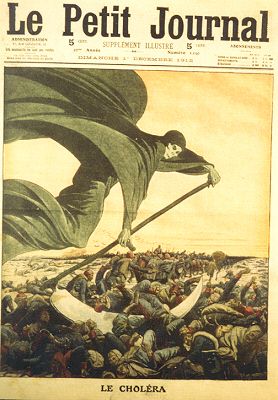Cholera risk factors
|
Cholera Microchapters |
|
Diagnosis |
|---|
|
Treatment |
|
Case Studies |
|
Cholera risk factors On the Web |
|
American Roentgen Ray Society Images of Cholera risk factors |
Editor-In-Chief: C. Michael Gibson, M.S., M.D. [2]
Overview
Choleria is a severe bacterial gastrointestinal, diarrheal disease. In its most severe forms, cholera is one of the most rapidly fatal illnesses known. A healthy person may become hypotensive within an hour of the onset of symptoms and may die within 2-3 hours if no treatment is provided. More commonly, the disease progresses from the first liquid stool to shock in 4-12 hours, with death following in 18 hours to several days without rehydration treatment.[1][2]
Risk factors
Recent epidemiologic research suggests that an individual's susceptibility to cholera (and other diarrheal infections) is affected by their blood type: Those with type O blood are the most susceptible,[3][4] while those with type AB are the most resistant. Between these two extremes are the A and B blood types, with type A being more resistant than type B.[citation needed]
About one million V. cholerae bacteria must typically be ingested to cause cholera in normally healthy adults, although increased susceptibility may be observed in those with a weakened immune system, individuals with decreased gastric acidity (as from the use of antacids), or those who are malnourished.
It has also been hypothesized that the cystic fibrosis genetic mutation has been maintained in humans due to a selective advantage: heterozygous carriers of the mutation (who are thus not affected by cystic fibrosis) are more resistant to V. cholerae infections.[5] In this model, the genetic deficiency in the cystic fibrosis transmembrane conductance regulator channel proteins interferes with bacteria binding to the gastrointestinal epithelium, thus reducing the effects of an infection.
Transmission

Persons infected with cholera have massive diarrhea. This highly liquid diarrhea, which is often compared to "rice water," is loaded with bacteria that can spread under unsanitary conditions to infect water used by other people. Cholera is transmitted from person to person through ingestion of feces contaminated water loaded with the cholera bacterium. The source of the contamination is typically other cholera patients when their untreated diarrhea discharge is allowed to get into waterways or into groundwater or drinking water supply. Any infected water and any foods washed in the water, and shellfish living in the affected waterway can cause an infection. Cholera is rarely spread directly from person to person. V. cholerae occurs naturally in the plankton of fresh, brackish, and salt water, attached primarily to copepods in the zooplankton. Both toxic and non-toxic strains exist. Non-toxic strains can acquire toxicity through a lysogenic bacteriophage.[6] Coastal cholera outbreaks typically follow zooplankton blooms. This makes cholera a zoonosis.
References
- ↑ McLeod K (2000). "Our sense of Snow: John Snow in medical geography". Soc Sci Med. 50 (7–8): 923–35. PMID 10714917.
- ↑ WHO Cholera [1]
- ↑ Swerdlow D, Mintz E, Rodriguez M, Tejada E, Ocampo C, Espejo L, Barrett T, Petzelt J, Bean N, Seminario L (1994). "Severe life-threatening cholera associated with blood group O in Peru: implications for the Latin American epidemic". J Infect Dis. 170 (2): 468–72. PMID 8035040.
- ↑ Harris J, Khan A, LaRocque R, Dorer D, Chowdhury F, Faruque A, Sack D, Ryan E, Qadri F, Calderwood S (2005). "Blood group, immunity, and risk of infection with Vibrio cholerae in an area of endemicity". Infect Immun. 73 (11): 7422–7. PMID 16239542.
- ↑ Bertranpetit J, Calafell F (1996). "Genetic and geographical variability in cystic fibrosis: evolutionary considerations". Ciba Found Symp. 197: 97–114, discussion 114-8. PMID 8827370.
- ↑ Archivist (1997). "Cholera phage discovery". Arch Dis Child. 76: 274.
External links
- CS1 maint: Multiple names: authors list
- All articles with unsourced statements
- Articles with unsourced statements from February 2007
- Articles with invalid date parameter in template
- Neurotoxins
- Foodborne illnesses
- Bacterial diseases
- Water-borne diseases
- Pandemics
- Biological weapons
- Neglected diseases
- Overview complete